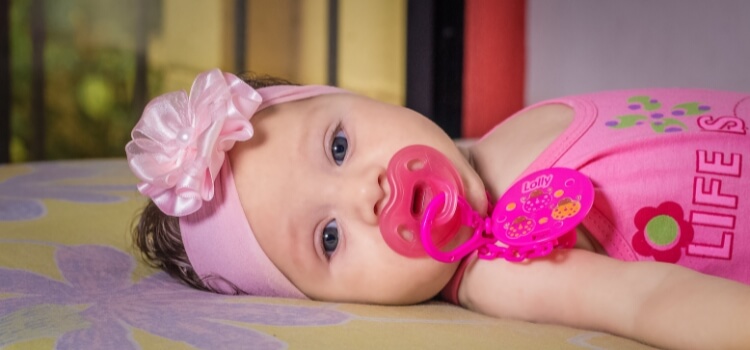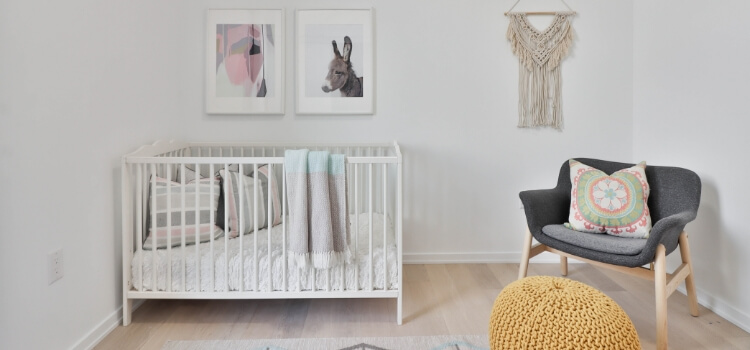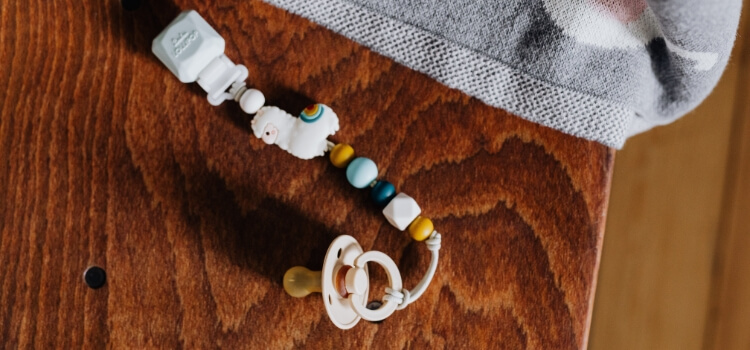As an Amazon Associate, I earn from qualifying purchases
If you’re a parent, you know the struggle of constantly finding pacifiers on the floor or under the crib. It can be frustrating and time-consuming to retrieve and clean pacifiers continually.
But fear not; there are solutions to this common problem! This blog post will examine several methods and tips to keep pacifiers from falling out of the crib. Say goodbye to the pacifier hunt and hello to peaceful nights of uninterrupted sleep!
How do you keep the pacifier in a crib?

There are many effective methods available to stop pacifiers from falling out of the crib and disrupting your baby’s sleep.
Securing the Crib
Place mesh netting inside the crib to act as a protective barrier
Mesh crib liners can be a practical solution for keeping pacifiers and other items within the crib while maintaining a safe sleep environment for your baby. These mesh liners, which also function as a type of bumper, are easy to install and offer several advantages. Here’s how to use them effectively:
Installation: Position the mesh liner against the inner walls of the crib, ensuring it covers the sides where you want to keep items within reach.
Attachment: Most mesh crib liners have ties or straps at each end. Securely tie these ends to the crib’s bars, keeping the liner in place.
Cost: Mesh crib liners typically range from $20 to $50, based on the qualities and brand. It’s advisable to invest in a breathable option to maintain proper air circulation within the crib.
Age Recommendation: While most mesh bumpers are marketed for children ages 0 to 3, it’s generally safer not to use them with newborns. This precaution helps reduce the risk of suffocation, as newborns have limited mobility and may inadvertently press against the mesh.
Mesh crib liners offer convenience and functionality for parents seeking to keep items within the crib while ensuring their baby’s safety during sleep. Following the installation guidelines and age recommendations, you can create a secure sleep environment for your little one.
Position the crib in a corner or against a wall to block two sides securely

Placing the crib against a wall or in a corner of the room is an effective way to keep pacifiers from falling out of the crib. This layout makes it more difficult for a pacifier to exit the crib, lowering the likelihood of it dropping to the floor. The child may feel more secure if the cot is placed against a wall.
1. Avoid Windows and Hanging Fixtures: Ensure that the crib is not placed near a window or any hanging fixtures or decorations that could pose potential hazards to the baby.
2. Flush Against the Wall: If the crib isn’t flush against the wall due to baseboards or other obstructions, it’s crucial to move it away from the wall. Leaving any space between the crib and the wall can be dangerous, as a baby’s arms or legs could become trapped.
Creating a safe and secure sleep environment for your baby is paramount. Proper crib placement and safety measures contribute to a peaceful and worry-free sleep experience for your little one.
Avoid placing blankets or plush toys near the crib’s borders
Avoid placing blankets between the crib bars to secure pacifiers is essential, as it poses a risk to your child’s safety. Items such as blankets, toys, pillows, or any similar objects inside the crib can lead to suffocation hazards. Ensuring crib safety necessitates keeping the crib empty for the well-being of your baby.
Think about using a pacifier with an attached animal or stuffed
Opting for a pacifier with a stuffer or attached animal is a clever strategy to keep it within the crib and prevent it from falling out. These pacifiers offer several benefits, enhancing their appeal and functionality for both babies and parents:
Added Weight and Resistance: The attached stuffed animal or soft accessory provides extra weight and resistance, making it more difficult for the pacifier to slip out of your baby’s mouth unintentionally.
Soothing Comfort: The presence of a stuffed animal or cuddly companion adds a relaxing factor, making the pacifier more appealing for your baby to grasp and hold onto. This comfort can help them self-soothe and feel secure, promoting a sense of calm during sleep.
Easy to Grasp: These pacifiers are designed to be easy for infants to grasp and hold. The attached stuffed animal is a handle, allowing your baby to maintain a firm grip on the pacifier. This design feature reduces the likelihood of the pacifier falling out of the crib, ensuring uninterrupted sleep for you and your little one.
Use Pacifier Clips or Holders

It is true that using pacifier clips or holders can significantly impact the prevention of pacifiers falling out of the crib. These practical attachments allow you to secure the pacifier to your baby’s outfit or the crib, ensuring it remains within reach and reducing the chances of it being lost or forgotten during the night.
The majority of pacifier clips include a clip at one end that secures your baby’s clothing, and they are often constructed of soft and durable fabrics. The other end of the clip has a loop or another explicitly intended to hold the pacifier. This simple yet efficient solution not only keeps the pacifier accessible but also keeps it from falling onto the crib floor, resulting in a more pleasant night’s sleep for both you and your baby. Pacifier clips are a valuable, safe addition to your baby’s nighttime needs.
Provide a variety of pacifiers
Offering multiple pacifiers within your baby’s reach is an excellent strategy to promote contentment and uninterrupted sleep in the crib. By providing several pacifiers, you increase the likelihood of your baby finding and keeping one in their mouth throughout the night, enhancing their comfort and facilitating continuous sleep.
Having multiple pacifiers readily available also enables swift replacement if one falls out or is misplaced during sleep. When your baby wakes up and instinctively searches for a pacifier, the presence of another one nearby ensures a quick and fuss-free solution. This accessibility reduces the chances of crying or complete wakefulness, allowing your baby to self-soothe and settle back into a peaceful sleep, contributing to a more restful night for both your baby and you.
Keep pacifiers close at hand
One of the most effective ways to keep your baby from getting restless or waking up in his crib is to have his pacifier handy. Pacifiers should be kept close to your child so they can find and get them quickly when needed, without having to wake up or get upset.
Pacifiers can be attached to the crib rails in an efficient manner by using pacifier holders or clips. It ensures easy access for your infant by keeping the pacifier in plain sight and within reach. As an alternative, pacifier pockets attached to the crib give your baby an easy place to find the pacifier by giving it a dedicated location.
Utilizing pacifiers readily available avoids the need for your baby to look for them in the dark or call for help. It encourages self-soothing by allowing your infant to reach for the pacifier and find comfort without requiring immediate parental assistance. This independence not only helps your baby get back to sleep faster, but it also builds their confidence in self-soothing, which contributes to healthier sleep patterns over time.
Keep a close eye on your child
Pacifiers should be kept in the crib by parents who frequently check on their infants while they sleep. This technique assures your baby’s comfort and safety while allowing you to handle any pacifier-related difficulties as soon as they develop.
You can examine if the pacifier is still in your baby’s mouth or within reach during routine check-ins. If the pacifier falls out or is out of your baby’s reach, gently place it back into their hands or firmly connect it to the crib using a pacifier clip.
The benefits of these routine check-ins go beyond just replacing pacifiers. They provide you with a chance to watch your baby’s behaviour and sleep patterns, which enables you to make sure they’re okay and take care of any other demands or worries that could come up at night. This careful approach helps create a calm and safe sleeping environment for your infant.
In Finalization
Remember, every baby is different, so you may need to experiment with other methods to find what works best for your little one. The key is to find a solution that keeps the pacifier secure and easily accessible when needed.
By implementing one or more of these strategies, you can minimize the frustration of constantly searching for pacifiers and ensure a peaceful and restful sleep for you and your baby.
Frequently Asked Questions
Pacifiers can fall out of the crib due to a few reasons. One reason may be that the baby is not able to keep the pacifier in their mouth yet. Another reason may be that the pacifier is not securely attached to a clip or holder.
There are a few things you can try to prevent pacifiers from falling out of the crib. One option is to use a pacifier clip or holder that attaches the pacifier to the baby’s clothing or crib. This can help keep the pacifier within reach and prevent it from falling out. Another option is to use a pacifier that is designed to stay in the baby’s mouth more securely, such as a pacifier with a built-in strap or a pacifier with a giant shield
Yes, there are a few additional tips you can try. You can place multiple pacifiers within reach in the crib, so if one falls out, the baby can easily find another one. You can also use a pacifier rope that attaches to the baby’s clothing or crib to keep the pacifier within reach. Additionally, you can position the baby in a way that makes it easier for them to access the pacifier, such as placing them on their back with their head slightly elevated.
The American Academy of Pediatrics recommends weaning the baby off pacifiers between 6 and 12 months. Prolonged pacifier use can interfere with speech and language development. It’s always a good idea to consult your paediatrician for guidance on the appropriate time to stop using pacifiers in the crib.
As an Amazon Associate, I earn from qualifying purchases
Leave a Reply